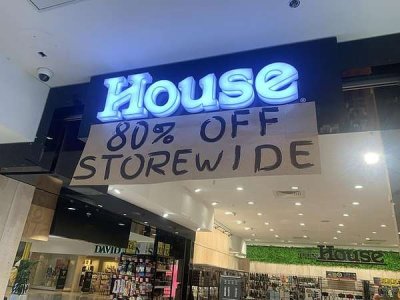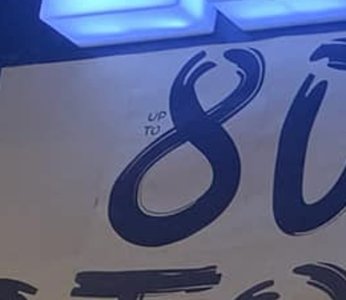Deceptive Sale Sign Outrages Aussie Shoppers
As advocates for savvier shopping, we at the Senior Discount Club recognise the significance of shedding light on deceptive marketing practices.
A specific instance of such questionable conduct has recently come to the forefront in Melbourne.
The unfolding drama took place in an Australian kitchenware retailer called House.
A mum, enticed by significant discounts, eagerly anticipated a customary shopping spree.

A prominently displayed banner, alluringly proclaiming an '80 per cent off storewide' sale, appeared like a valuable offering from the realm of retail.
After all, who could resist the opportunity to seize remarkable bargains on exquisite kitchenware?
It turns out the glimmering banner of deals contained a less shiny surprise. A shopping heroine spotted the divisive detail—a tiny 'up to' scribbled before the '80 per cent off'.
Now, who would have thought to spot that letdown in all their heady discount-driven excitement?
It meant that discounts ranged anywhere from a meagre one per cent to a majestic 80 per cent off—a painful trick for any bargain seeker.
Infuriated and deceived, the shopper took to Facebook to voice her disdain, challenging others to decipher the invisible detail on their screens.
She said, 'I thought this sale was fantastic until I got to the register to pay. I personally think it crosses the line of being misleading when the fine print is so small you can barely see it when walking into the store.’
Her feelings of outrage were shared by numerous unsuspecting shoppers who echoed her sentiments.
One said, 'They've definitely triple jumped over the line between confusing and misleading advertising.’

Another added, 'Gee wiz, that is pushing the envelope, isn't it!'
A third wrote, 'Bait advertising. I don't understand how it's allowed for so long.'
A fourth, 'Horrible marketing. Whoever has thought this was a good idea should maybe not be in marketing.'
Keen readers even spotted further deception in the sale sign's tinier text—'RRP' (Recommended Retail Price)—indicating the discount applied to the original price, not any previously discounted rate. Double whammy, wouldn't you say?
'See the RRP near the F also. No way would I shop there.' a mum noted.
'I'm not a Karen but I would have argued that one, then vowed to never shop there again!' another commented.
Responding to the adversity, a House spokesperson claimed that corrective actions were underway to clarify the sale sign.
In their words, 'It came to our attention that the signage at our Southland store did not clearly state that the discounts were up to 80 per cent. As soon as this came to our attention, the sign was immediately corrected.'
'At all times, the extent of the discount was clearly identified on the product within the store.'

Let us strive to make shopping clean, fair and deceptive-free. Don't be bait advertising's next casualty!
Have you ever encountered deceptive sale signs or misleading advertising tactics while shopping? How do you think retailers should ensure transparency and clarity in their promotions to avoid misleading customers? Share your thoughts with us!
A specific instance of such questionable conduct has recently come to the forefront in Melbourne.
The unfolding drama took place in an Australian kitchenware retailer called House.
A mum, enticed by significant discounts, eagerly anticipated a customary shopping spree.

It is crucial for retailers to maintain transparency and honesty in their sales promotions to build trust with customers. Source: Facebook
A prominently displayed banner, alluringly proclaiming an '80 per cent off storewide' sale, appeared like a valuable offering from the realm of retail.
After all, who could resist the opportunity to seize remarkable bargains on exquisite kitchenware?
It turns out the glimmering banner of deals contained a less shiny surprise. A shopping heroine spotted the divisive detail—a tiny 'up to' scribbled before the '80 per cent off'.
Now, who would have thought to spot that letdown in all their heady discount-driven excitement?
It meant that discounts ranged anywhere from a meagre one per cent to a majestic 80 per cent off—a painful trick for any bargain seeker.
Infuriated and deceived, the shopper took to Facebook to voice her disdain, challenging others to decipher the invisible detail on their screens.
She said, 'I thought this sale was fantastic until I got to the register to pay. I personally think it crosses the line of being misleading when the fine print is so small you can barely see it when walking into the store.’
Her feelings of outrage were shared by numerous unsuspecting shoppers who echoed her sentiments.
One said, 'They've definitely triple jumped over the line between confusing and misleading advertising.’

Deceptive practices can lead to customer dissatisfaction, loss of credibility, and long-term damage to the brand's reputation. Source: Facebook
Another added, 'Gee wiz, that is pushing the envelope, isn't it!'
A third wrote, 'Bait advertising. I don't understand how it's allowed for so long.'
A fourth, 'Horrible marketing. Whoever has thought this was a good idea should maybe not be in marketing.'
Keen readers even spotted further deception in the sale sign's tinier text—'RRP' (Recommended Retail Price)—indicating the discount applied to the original price, not any previously discounted rate. Double whammy, wouldn't you say?
'See the RRP near the F also. No way would I shop there.' a mum noted.
'I'm not a Karen but I would have argued that one, then vowed to never shop there again!' another commented.
Responding to the adversity, a House spokesperson claimed that corrective actions were underway to clarify the sale sign.
In their words, 'It came to our attention that the signage at our Southland store did not clearly state that the discounts were up to 80 per cent. As soon as this came to our attention, the sign was immediately corrected.'
'At all times, the extent of the discount was clearly identified on the product within the store.'
Key Takeaways
- A Melbourne shopper was frustrated by a 'misleading' sale sign at Australian kitchenware store House, slating the company for a hidden 'up to' message in the sale sign.
- The onslaught of complaints came after customers noted tiny, practically invisible, details on the sale sign specifying that the discount applies to the 'Recommended Retail Price (RRP)' and can vary between 1 per cent and 80 per cent.
- Reactions to the sign varied online, with some users finding the advertising tactics deceptive.
- A House spokesperson said the signage issue at the Southland store has been quickly corrected and clarified that the extent of the discount was always clearly identified on the products within the store.
Let us strive to make shopping clean, fair and deceptive-free. Don't be bait advertising's next casualty!
Have you ever encountered deceptive sale signs or misleading advertising tactics while shopping? How do you think retailers should ensure transparency and clarity in their promotions to avoid misleading customers? Share your thoughts with us!







